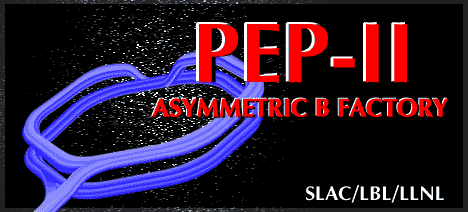 09/19/97 Update
09/19/97 Update
 09/19/97 Update
09/19/97 Update
September 19, 1997
During the past week PEP-II commissioning has been aimed at raising the beam current and commissioning the feedback systems.
The new timing system for PEP-II injection (Marc Ross, Mike Ronan, Tony Gromme, Mike Stanek, Vinod Bharadwaj, Ron Chestnut, Jim Turner and others) synchronizes the linac and damping ring bunches to PEP-II buckets. This computer controlled system is very easy to use allowing any desired bunch pattern from 1 to 1746 bunches to be filled in any sequence and with bunch gaps. [The ring harmonic number is 3492=97*3*3*2*2. Thus, bunch totals of 97*3=291, 97*2=192, 2*2*3=12, 97*2*3*3=1746, etc are uniform fill patterns.]
After we tuned injection trajectories and ring injection bumps, e- injection rates of 0.2 mA/sec at 1 Hz and 2.2 mA/sec at 10 Hz were routinely achieved with injection efficiencies from 60 to 90%.
Using three RF stations with a total voltage of about 9 MV, a total current of 281 mA in 1700 bunches was reached. 1658 is the design number of bunches and 281 mA is 28% of the design current. This current was achieved in several bunch patterns. At this peak current the injected rate slows and there are occasional 20 mA beam losses. The beam also appears to be unstable on the synchrotron light monitor but the cause is not yet known. No feedbacks except for RF phase loops were used. The vacuum chamber temperatures have only increased a few degrees (F).
The "sawtooth" instability as seen in June is now gone. It went away with the replacement of the last bellows without internal RF fingers. [The theorists are still working on this one.]
The beam lifetimes are also good and real time scrubbing is evident day to day. At 250 mA the lifetime is about 2 hrs and at 160 mA the lifetime is about 3.5 hrs. At low currents the lifetime is over six hours. Between accelerator studies, beam fills at these currents have been kept in the ring for several multi-hour periods.
In order to increase the beam current further, the feedback systems are likely needed. The transverse and longitudinal systems are ready and have been fully tested with beam. The RF feedback systems have made great progress in the past week with individual parts being tested successfully with beam. We're hoping that soon we can run all feedbacks simultaneously. So far we have only turned them on with the experts present.
The next period for HER studies include background measurements at the interaction point, going to the full IR optics (quads at full strength), and raising the beam energy to 9 GeV.
Congratulations to all on acheiving these high currents.
John Seeman
Suggestions to: John Seeman
[PEP-II Commissioning Updates] [PEP-II Home Page] [BABAR Detector Home Page] [SLAC Home Page]
Page owner: achan